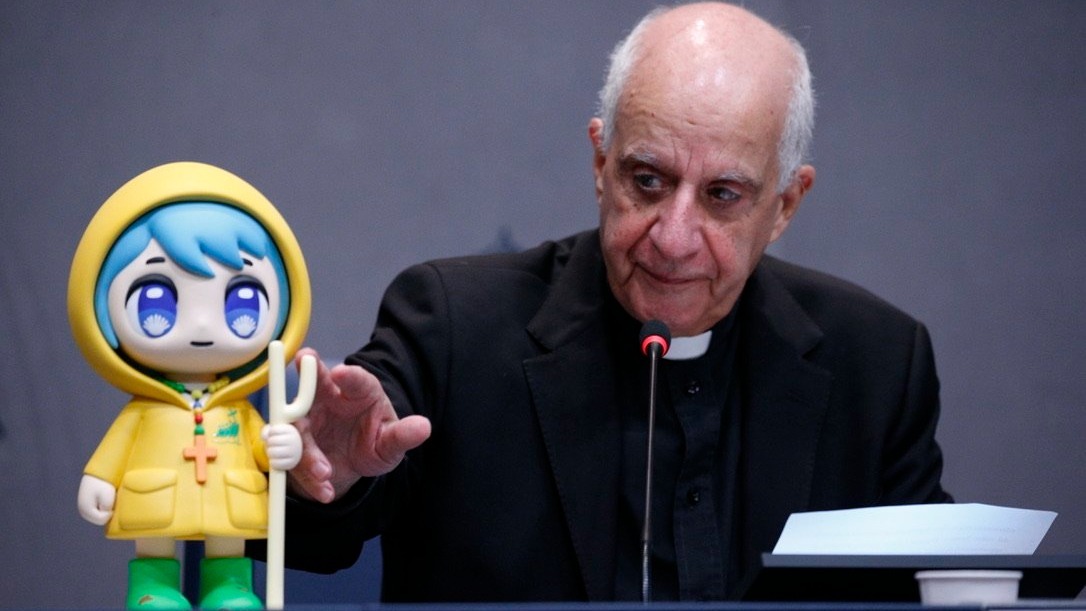Earlier this week, the Vatican unveiled Luce: a cheerful little girl with big eyes, blue hair, and a yellow raincoat. Introduced as the mascot for both the 2025 Jubilee year and the Vatican’s pavilion at Expo 2025, she represents what Archbishop Rino Fisichella, the Vatican’s chief Jubilee organiser, describes as an effort to appeal to younger generations. Most importantly, though, Luce is an anime girl.
The choice of a “kawaii” anime girl isn’t arbitrary. While Luce is certainly a nod to the World Expo’s 2025 location of Osaka in Japan, anime has also emerged in the last decade as a global cultural lingua franca. From Saudi Arabia, which has invested in its own anime production initiatives, to major anime conventions across the Philippines, Mexico, Brazil, and India, anime’s influence transcends Japan’s broader decline in soft power. Anime, in many ways, has become bigger than Japan itself. The whole world loves anime now, and its visual language crosses borders with an ease matched only by the likes of Elvis or Marilyn Monroe.
This timing coincides with Catholicism’s significant demographic shifts. While Europe has lost approximately 461,000 Catholics, the global Catholic population has grown by 13.7 million to reach 1.39 billion, with Africa alone gaining 7.3 million new Catholics and expansion in Asia. Catholicism is growing — just not in Europe or North America, where pews remain comparatively empty.
Curiously, though, the American and British media have spent the last three years breathlessly reporting on a supposed Gen-Z Catholic revival, from the faux TradCaths of Dimes Square to #CatholicCore on TikTok to Nick Fuentes’s far-Right following and #tradwives across social platforms. There are even a few “guru” priests in the mix, such as the controversial Father Mathieu Jasseron, who boasts 1.2 million followers. We’ve been hearing since 2021 that Zoomers love Catholicism.
Yet this fascination hasn’t translated into religious participation, not even in Traditional Latin Mass which is — or at least was — apparently “surging” in popularity. Generation Z shows historically low rates of religious engagement: 34% are religiously unaffiliated, and 38% never attend religious services. The enthusiasm for mantillas or rosaries as “aesthetic” hasn’t led to increased religious practice. Instead, traditional Catholic imagery has become another element in fast fashion, stripped of its spiritual significance. Or maybe the situation is even more dire than that: Catholicism been used as a prop to play-act religion, without any genuine investment. It’s all fun and games until you have to go to confession and be honest about all the “premarital” you’ve been having.
Still, these blips on the radar — these aesthetic trends, the Catholic imagery on social media, the memes — could have been capitalised on by the Vatican. A wink to the audience, an exhortation that maybe instead of wearing your rosary as a necklace, you should try praying sometimes. But no exhortations are to be found, not this year, nor when Catholicism was going viral three years ago. Its flash-in-the-pan aesthetic resonance in the early 2020s seemed to only be appealing to the press.
The Vatican’s apparent disinterest in seizing on social media’s Catholic fever suggests either unawareness or, more likely, a deliberate choice to pursue a more global strategy, which is where Luce enters the picture. While Americans and Europeans consume anime enthusiastically, so does the rest of the world, making it truly Catholic in reach. This universal appeal mirrors the Church’s own aspirations to universality, making anime an unexpectedly appropriate medium for Catholic messaging.
Such restraint in not chasing Western social media trends might not be a missed opportunity. While these trends are great TikTok fodder, they remain fundamentally Western. So, American girls are donning mantillas and Sabrina Carpenter is doing her sexy Madonna role play: this is all peripheral to Catholicism’s future. In this light, Luce represents something more significant than just another marketing strategy. She embodies the Church’s recognition that its future vitality depends on its ability to communicate across cultural boundaries while maintaining its essential message.
Whether Luce succeeds in her mission to engage young Catholics worldwide remains to be seen. But the Church is willing to take a chance on her.











Join the discussion
Join like minded readers that support our journalism by becoming a paid subscriber
To join the discussion in the comments, become a paid subscriber.
Join like minded readers that support our journalism, read unlimited articles and enjoy other subscriber-only benefits.
Subscribe